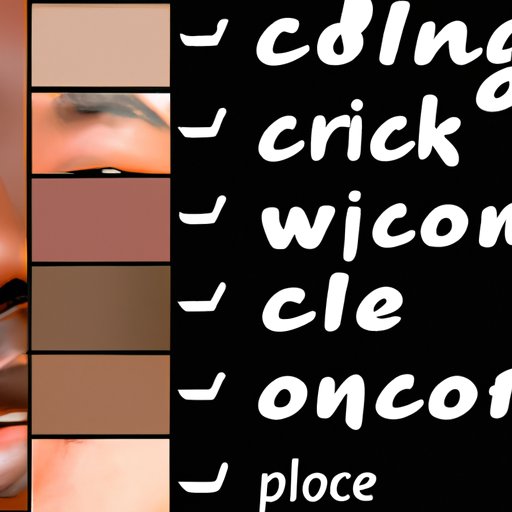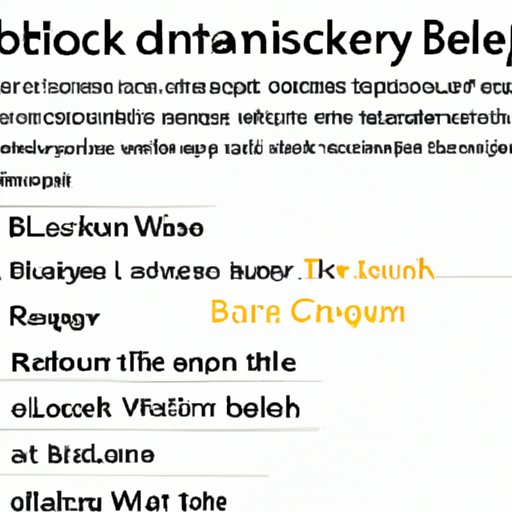Introduction
When creating characters for stories or writing about people, capturing the nuances of skin color can be a challenge. It is important to have accurate descriptions of skin tone, as well as to avoid stereotypes or offensive language. In this article, we provide guidance on how to accurately and effectively describe skin color in writing.
Use Metaphors and Similes to Describe Skin Color
Metaphors and similes are powerful tools for describing skin color. A metaphor is a comparison that does not use the words “like” or “as.” For example, you could say someone has skin like the moon, or eyes as bright as the sun. A simile is a comparison that uses the words “like” or “as.” For example, you could say someone has skin as smooth as silk, or eyes as dark as coal.
Using metaphors and similes to describe skin color can help bring your writing to life. Metaphors create vivid imagery, and similes provide a direct comparison that is easy for readers to understand. They also give you an opportunity to incorporate other elements of nature into your descriptions, such as the sky, sea, or mountains.

Utilize Color Words to Capture the Nuances of Skin Tones
Color words are another way to accurately describe skin color. Understanding undertones is key to choosing the right color words. Undertones are the subtle hues beneath the surface of the skin that can affect the overall appearance. For example, someone with pale skin might have cool undertones (blue, pink, or purple) or warm undertones (yellow, gold, or orange).
Once you understand the undertones, you can choose appropriate color words to describe the skin. For example, someone with pale skin and cool undertones may be described as having porcelain or ivory skin, while someone with pale skin and warm undertones may be described as having peachy or golden skin. Color words can also be used to describe darker skin tones, such as chestnut, chocolate, or ebony.

Incorporate Cultural References to Describe Skin Color
Cultural references can be used to describe skin color in a more nuanced and accurate way. Consider researching the terms used to describe skin color in different cultures around the world. For example, in India, people may refer to light skin tones as “wheatish,” while in China, they may refer to dark skin tones as “beautiful black.”
Incorporating cultural references into your writing can make your descriptions more accurate and authentic. It also adds a layer of depth to your writing, as it implies knowledge of different cultures and their customs. However, it is important to research these terms carefully and use them with sensitivity and respect.
Incorporate Texture Descriptions to Enhance Your Writing
Texture descriptions provide another way to enhance your writing when describing skin color. Instead of simply describing the color of someone’s skin, you can also describe its texture. For example, you could say someone has skin as soft as velvet, or skin as rough as sandpaper.
Texture descriptions can help bring your writing to life by providing more detail and making it easier for readers to visualize the character. They also allow you to incorporate other elements of nature into your descriptions, such as fur, feathers, or petals.

Leverage Literary Devices to Create Unique Descriptions of Skin Color
Finally, literary devices can be used to create unique and interesting descriptions of skin color. Alliteration is a literary device in which the same sound is repeated at the beginning of multiple words. For example, you could say someone has creamy caramel skin, or rosy raspberry skin.
Personification is another literary device in which human characteristics are attributed to non-human things. For example, you could say someone has skin as radiant as the sun, or skin as mysterious as the night. Using literary devices to describe skin color can add a layer of creativity and uniqueness to your writing.
Conclusion
Describing skin color in writing can be a difficult task, but there are ways to make it easier. By using metaphors, color words, cultural references, texture descriptions, and literary devices, you can accurately and effectively capture the nuances of skin tone in your writing. We hope this article has provided you with some helpful guidance on how to do so.
In summary, there are many ways to accurately and effectively describe skin color in writing. Metaphors and similes can create vivid imagery, color words can capture the nuances of skin tones, cultural references can add authenticity, texture descriptions can bring your writing to life, and literary devices can create unique descriptions. With these tools, you can create accurate and engaging descriptions of skin color in your writing.
Next Steps for Writers
Now that you have a better understanding of how to accurately and effectively describe skin color in writing, it’s time to put your knowledge into practice. Start by researching the terms used to describe skin color in different cultures. Then, practice using metaphors, color words, cultural references, texture descriptions, and literary devices to create unique and accurate descriptions of skin tones.
(Note: Is this article not meeting your expectations? Do you have knowledge or insights to share? Unlock new opportunities and expand your reach by joining our authors team. Click Registration to join us and share your expertise with our readers.)
